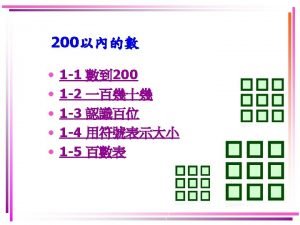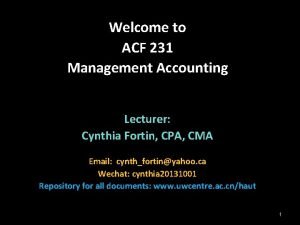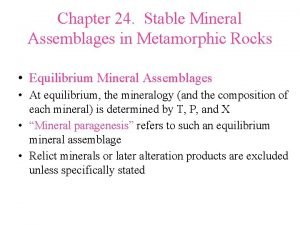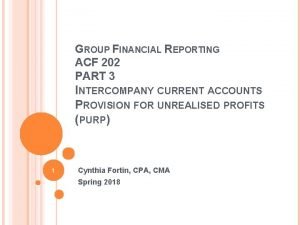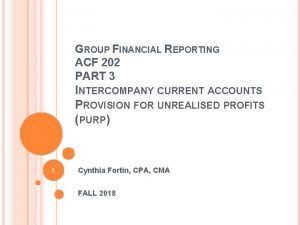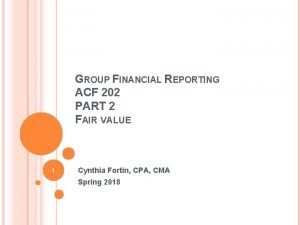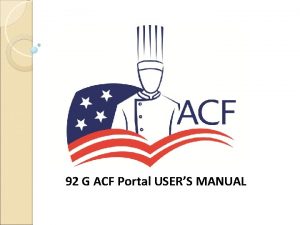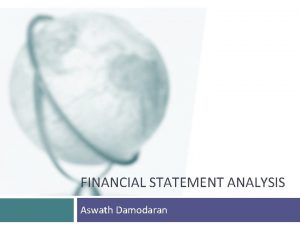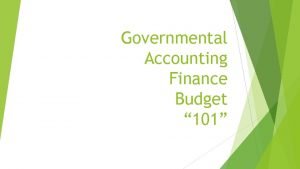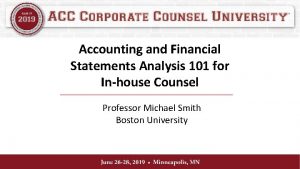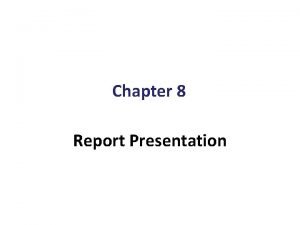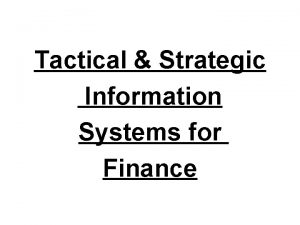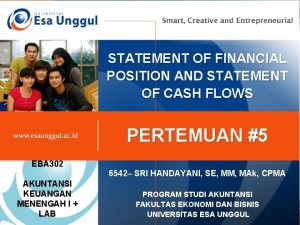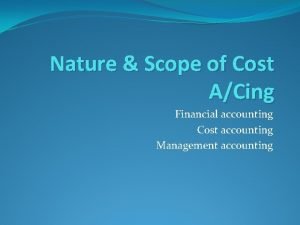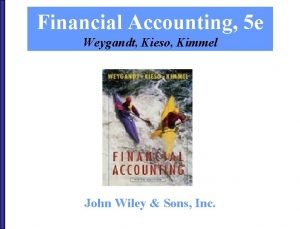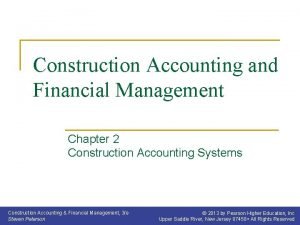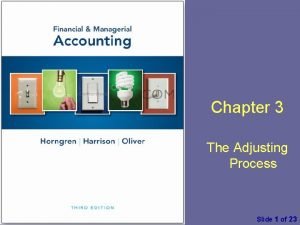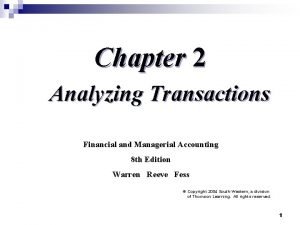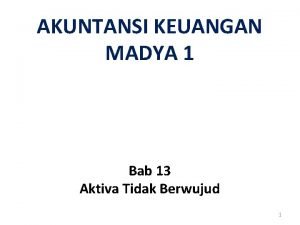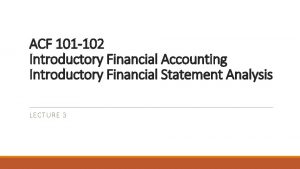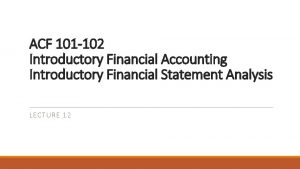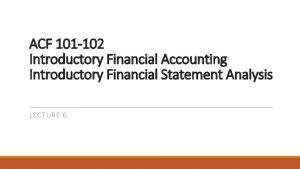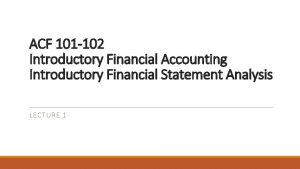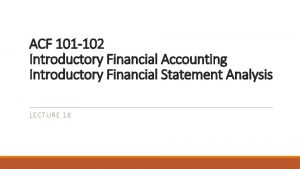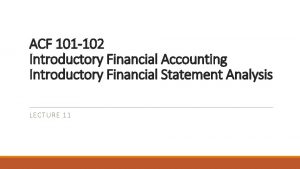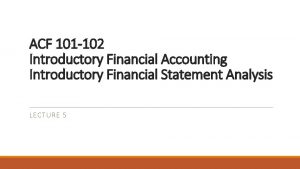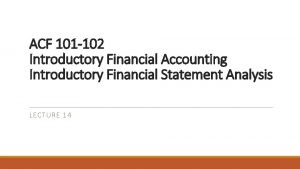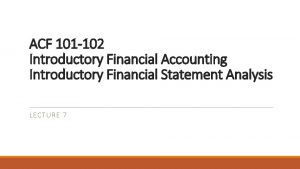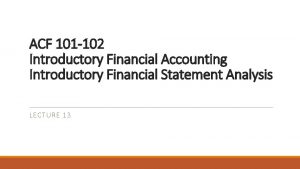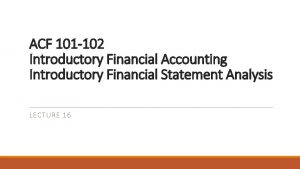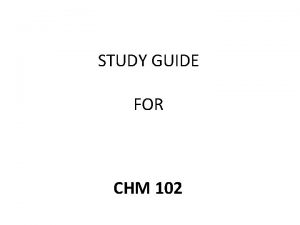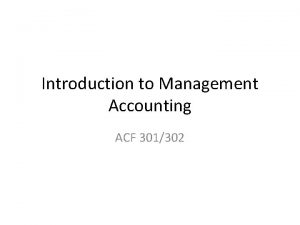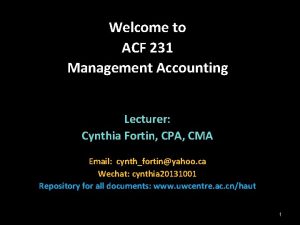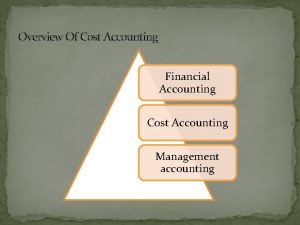ACF 101 102 Introductory Financial Accounting Introductory Financial



































- Slides: 35

ACF 101 -102 Introductory Financial Accounting Introductory Financial Statement Analysis LECTURE 10

Learning Outcome Demonstrate knowledge and understanding of the various forms of analysis in financial statements analysis Explain how to analyse financial statements and demonstrate ability to calculate important basic financial relations and methodologies Describe the uses and purposes of Financial statements for analysis of firms

Topics Financial Statement Analysis Treatment of sales (cash/credit) Bad debts Bank reconciliation

Financial Statement Analysis Financial statement analysis is the process of analysing a company's financial statements for decisionmaking purposes and to understand the overall health of an organisation.

Financial statements record financial data, which must be evaluated through financial statement analysis to become more useful to investors, shareholders, managers, and other interested parties.

Techniques of Financial statement analysis 1. Horizontal Analysis 2. Vertical Analysis 3. Ratio Analysis

Horizontal Analysis Compares two or more years of financial data in both monetary and percentage form

Vertical Analysis Each category of accounts on the balance sheet is shown as a percentage of the total account

Ratio Analysis Calculates statistical relationships between data.

Financial statement analysis allows analysts to identify trends by comparing ratios across multiple periods and statement types. These statements allow analysts to measure liquidity, profitability, company-wide efficiency, and cash flow.

Revenue Recognition Revenue results from the sale of goods/services to a customer and should be recognized when ◦ It is earned - Goods or services have been delivered ◦ It is realized – title has transferred and cash has been received ◦ Or is realizable – if another asset other than cash (e. g. Accounts Receivable) is received and is virtually assured of being converted into cash

Most companies recognize revenue at the point of sale but there are unique circumstances

Revenue Recognition Cash is received before goods or services have been delivered Cash 1, 000 Unearned (deferred) Revenue (liability) 1000 ◦ A portion (50%) is completed but not delivered (percent of completion method) Expenditures Cash Unearned Revenue Sales Revenue 500 (50% of expected total) 500 500

Revenue Recognition Revenue is recorded at the cash-equivalent value of what is received. For example ◦ A sale occurs that has a sticker price of $100 ◦ To entice the buyer, a $5 discount is offered and accepted; the customer charges the purchase Accounts Receivable Sales Discounts * Revenue * * 95 5 100 (Contra revenue account) Net sales revenue would be reported at $95 (100 – 5) but two accounts would be used to capture the event

Cash and Credit Sales Revenue A $100 cash and $100 credit sale Cash Accounts Receivable Sales Revenue 100 200 ◦ Credit sales increase revenues (and thus expenses) ◦ Credit sales also lead to 1) costs of managing credit and collections and 2) uncollectable accounts ◦ If net revenue > the related expenses, credit sales are good for the business ◦ Costs and benefits should be periodically assessed

Sales Returns/Allowances, Trade and Cash Discounts, Credit Card Fees Income Statement Gross Sales $1, 400 Less Sales Returns ($100) Sales Allowances ($10) Contra Revenue (Debit Balance) Trade Discounts ($10) Accounts Cash Discounts ($2) Credit Card Fees ($3) $125 Net Sales $1, 275 ◦ Reports to shareholders typically omit details and show only net revenues (Maybe details are in footnotes)

Sales Returns - when a customer returns previously purchased merchandise to the seller (“purchase returns” used by buyers) Cost of Goods Sold 60 Inventory 60 The purchase Accounts Receivable 100 Sales Revenue 100 Inventory 60 Purchase Returns/Allowances 60 Sales Returns 100 Accounts Receivable 100 Contra COGS

Sales Allowances Sales Allowance is a reduction of the original selling price Cost of Goods Sold Inventory Accounts Receivable Sales Revenue 60 100 ◦ Purchaser notes lower price ($90) at another store and asks for a $10 price reduction which is given Sales Allowances Accounts Receivable 10 10

Cash Discounts – an encouragement to the retailer to quickly pay the wholesaler ◦ Usage varies by company and industry n/30 - Full billed price (net price) due in 30 days 15 E. O. M. – Due 15 days after end of the month “ 2/10/n 30” ◦ 2% off invoice price ◦ If paid within 10 days of invoice date ◦ Net amount due in 30 days after invoice date

Cash Discounts (“ 2/10/n 30”) - gross method ◦ Sale Accounts Receivable 100 Sales Revenue ◦ Customer pays ◦ Within 10 days Cash 98 Cash Discounts Taken 2 Accounts Receivable ◦ After 10 days Cash Accounts Receivable 100 100

Cash Usually report cash and cash equivalents on the balance sheets as a single amount Cash – money, money orders, checks Cash equivalents - highly liquid short-term investments that can easily and quickly be converted into cash (< 90 days until maturity) ◦ Time deposits ◦ Commercial paper ◦ 90 -day Treasury bills

Cash management is important and therefore justifies strong internal controls ◦ Must hold adequate cash to run the business ◦ Cash loses purchasing power during inflationary times justifying holding little excess cash) ◦ While cash balances may seem large, cash in- and out-flows during the year are much larger ◦ Cash, being the most liquid asset is enticing to thieves and embezzlers ◦ Cash earns little to no return (generally the least productive of all the assets)

Cash The major internal control procedures set up to safeguard cash include: ◦ Separate persons receive and disburse cash ◦ Separate persons handle cash and accessing accounting records ◦ Record and deposit cash receipts immediately ◦ Make disbursements using serially numbered checks, and require proper authorization by someone other than the person writing the check ◦ Reconcile bank accounts monthly by someone who does not write the checks

Bad debts The provision for doubtful debts is the estimated amount of bad debt that will arise from accounts receivable that have been issued but not yet collected. It is identical to the allowance for doubtful accounts.

Uncollectible Accounts Direct (specific write-off) method ◦ Assume all receivables are collectable, i. e. , do nothing at year end to modify income or receivables ◦ When it becomes apparent a receivable ($200) will not be collected (unable or unwilling), write it off Bad Debts Expense 200 Accounts Receivable 200 ◦ If sales revenue was recorded last year and write-off occurred this year, poor “matching” ◦ Says nothing about the remaining credit revenue and receivables – will some of them become bad debts?

Uncollectible Accounts Allowance method – Common elements ◦ Adjusting entry at year-end (* Contra Receivable) Bad Debts Expense Allowance for Doubtful Accounts * 4000 ◦ Balance Sheet Accounts Receivable $250, 000 Less: Allowance for Doubtful Accounts * ($4, 000) Net Accounts Receivable $246, 000 ◦ Write off a $200 account this or next year Allowance for Doubtful Accounts Receivable * 200

Assessing Accounts Receivable Cash sales produce cash instantly Credit sales generally cause sales to increase but they also delay cash receipts. ◦ Major credit cards ◦ Just a few days before credit card company transfers cash to the company ◦ Some treat these receivables as cash equivalents ◦ Company credit cards – using last year’s data ◦ How long did it take to collect receivables ◦ Is that length of time acceptable?

Assessing Accounts Receivable Turnover Ratio Credit Sales = $1, 000 Average Receivables $115, 000 + $112, 000 2 = 8. 81 ◦ On average, receivables were created then collected 8. 81 times in the past year ◦ Higher turnovers indicate that a company collects its receivables faster ◦ Lower turnover indicates slower collection

Assessing Accounts Receivable Number of days to collect Accounts Receivable 365 days per year 365 = 41. 4 days Receivables Turnover Ratio 8. 81 ◦ On average, last year receivables were collected 41. 4 days after being created ◦ Higher # days puts more pressure on firm to find alternative cash sources while awaiting collection ◦ Lower # days – less pressure ◦ Varies by company and industries

Internal Control Internal control - a system of checks and balances that ensure company actions are proper and approved by management ◦ Administrative controls spell out responsibilities for ◦ Reporting ◦ Budgeting ◦ Performance evaluation ◦ Granting credit to customers ◦ Protecting assets ◦ Etc.

Internal Control Internal controls - Accounting controls ◦ Transactions are what management intended ◦ Recording authorized transactions accurately ◦ Safeguarding assets - prevent unauthorized access ◦ Reconciling records to other records or observations ◦ Valuation - amounts are reviewed for impairment and writedowns ◦ Operational efficiency - least amount of waste, errors, fraud

Internal Control Good internal control systems have these things in common: ◦ Reliable personnel with clear responsibilities ◦ Separation of duties makes it harder to collude ◦ Adequate documentation (source documents) ◦ Proper authorization for normal/abnormal transactions ◦ Well-documented policies and procedures ◦ Physical safeguards over items of value ◦ Vacations and rotation of duties ◦ Independent review of all systems ◦ Cost-benefit considerations should apply

Internal Control SEC requires publically traded companies to have an Audit Committee ◦ Composed of independent members ◦ Responsible for companies’ financial affairs Sarbanes-Oxley Act – 2002 - Requires management to ◦ Assess and report on its internal controls ◦ Requires independent auditors to review management’s assessment and offer their assessment of that effort

Bank Reconciliation • Purpose is to explain why the bank statement differs from the account owner’s records

Bank Reconciliation Complete Depositor Bank statement 11, 000 Deposit 4, 000 Deposit 6, 000 Deposit 7, 000 Check (2, 000) Check (3, 000) Check (5, 000) Check (10, 000) Beginning Balance Fee Ending Balance Adjustment (20) 7, 980 (20) 8, 000 10, 980 (20) 7, 000 Adjustment Final Balance (10, 000) 7, 980
 100 101 102
100 101 102 Prime numbers till 200
Prime numbers till 200 Intermediate accounting chapter 1
Intermediate accounting chapter 1 Advanced corporate accounting ppt
Advanced corporate accounting ppt Acf 231
Acf 231 3m acf
3m acf Army cadet force values and standards powerpoint
Army cadet force values and standards powerpoint Acf certification levels
Acf certification levels Army cadet force syllabus
Army cadet force syllabus Acf diagram metamorphic rocks
Acf diagram metamorphic rocks Aws academy cloud foundations (acf)
Aws academy cloud foundations (acf) Intercompany margin
Intercompany margin Acf 202
Acf 202 Acf 202
Acf 202 Portal acf
Portal acf Acf ncf
Acf ncf Acf formula
Acf formula Aswath damodaran accounting
Aswath damodaran accounting Government accounting 101
Government accounting 101 Inhouse financial statement
Inhouse financial statement Aasb 101
Aasb 101 What are the advantages of computerized accounting
What are the advantages of computerized accounting Materiality concept
Materiality concept Tactical information system
Tactical information system Statement of financial position account form
Statement of financial position account form Scope of management accounting
Scope of management accounting Nature and scope of cost accounting
Nature and scope of cost accounting Management accounting nature and scope
Management accounting nature and scope Kimmel accounting 5e
Kimmel accounting 5e Construction cost accounting basics
Construction cost accounting basics Income statement in financial accounting
Income statement in financial accounting Financial accounting chapter 2 solutions
Financial accounting chapter 2 solutions Unit 5 lesson 2 financial accounting
Unit 5 lesson 2 financial accounting Unit 5 lesson 2 financial accounting
Unit 5 lesson 2 financial accounting Financial accounting chapter 13
Financial accounting chapter 13 Equity accounted investments
Equity accounted investments
